Reducing Medical Errors, Promoting Patient Safety - PowerPoint PPT Presentation
1 / 19
Title:
Reducing Medical Errors, Promoting Patient Safety
Description:
Reducing Medical Errors, Promoting Patient Safety Every Patient s Right Everyone s Responsibility Primum non nocere - Hippocrates Sharon Levine, MD – PowerPoint PPT presentation
Number of Views:887
Avg rating:3.0/5.0
Title: Reducing Medical Errors, Promoting Patient Safety
1
- Reducing Medical Errors, Promoting Patient Safety
Every Patients RightEveryones Responsibility
Primum non nocere - Hippocrates
Sharon Levine, MD Associate Executive
Director Kaiser Permanente October 20-21,
2008 Beijing, China
2
- Medicine used to be simple, effective and
relatively safe - now it is complex, effective,
and potentially dangerous - Sir Cyril Chantle
- 44,000-98,000 patients die each year in
hospitals from medical error IOM report May
be as high as 195,000 deaths per year Health
Grades 2004 - Our Challenge
- Preventing harm to patients from the care
intended to help them
2
3
Accidental Deaths in the U.S.
(National Safety Council, Harvard School of
Public Health, 1999)
3
4
How Do We Compare?
4
5
Top Patient Concerns About Hospital
Stays
- Negative interaction of medications 58
- Getting the wrong medications 61
- Cost of treatment 58
- Procedural complications 56
- Having enough drug information 53
- Getting an infection during stay 50
- Suffering from pain 49
5
6
Basis Of Error Complexity
- Powerful drugs
- Highly technical equipment/products
- Rapid decisions time pressured
- Many care givers multiple handoffs
- Task-based versus Systems-based
- Limited resources
- Complex human factors
- High acuity illness / injuries
- Environment prone to distraction
- Variable patient volume variable patient flow
Requires more than paying attention and trying
hard
6
7
Basis of Error - Complexity
- 80 medical error is system derived
- 95 mistakes the good guys
- Identify and address the human factors
- Fix the system
- Understand the difference
7
8
Culture of Safety
- Awareness, understanding, and ownership of
safety by all - Constant vigilance to prevent error
- Learning from errors that do occur, and minimize
chance of recurrence - Teamwork, not hierarchy or autonomy
- Communication and hand-offs
- Non-punitive environment - encourage reporting of
errors and near-misses - Systems to mitigate human factors
- Memory capacity
- Mental processing
- Stressors fatigue, emergencies
8
9
Behavior
Biggest barrier to preventing errors punishing
people for making mistakes
- Human error--inadvertently doing other than what
should have been done slip, lapse, mistake -
console - At risk behavior - behavior where risk is not
recognized, or is mistakenly believed to be
justified - coach - Reckless behavior - conscious disregard of a
substantial and unjustifiable risk remedial,
then disciplinary action - David Marx
9
10
Culture of Systems
- From patient-specific to systems view
- Indentifying patterns of error
- Standardization where appropriate processes,
procedures, checklists, standardized orders - Care team accountability for error identification
and elimination - Expert team vs. team of experts communication,
simulation, attention to hand-offs
10
11
Drivers of Hospital Mortality and Morbidity
Goals Drivers Focus Areas
Initiatives
Infection Reduction
No Needless Harm/Deaths
Falls and pressure ulcers
High Alert Medication Program
Highly Reliable Surgical Teams
Reduce Hospital Mortality and Morbidity
Disease-specific care AMI, HF, PN, SCIP, CVA,
glucose control
Evidence- Based Care
Early goal-directed therapy
Anticipating end of life Palliative Care,
Advance Directives
Appropriate Care Setting
Access to alternative care settings SNF, HH,
rehab
11
12
High Alert Medication Program
- High Alert Drug List
- Standardize policies and procedures
- Education, training and retraining
- No-interruption zone, -wear
- Peer observations
- Measure, monitor, feedback
- Peer group share learnings
- Leadership focus, oversight
12
13
Zone
MedRite
The Zone is an area marked out in
front of the PYXIS to signify a no interruption
area. Use of tape is a common zone indicator in
hospitals such as in the OR and Pharmacy
13
14
No Interruption Wear (NIW) is the tool that helps
minimize interruptions during medication
administration Worn ONLY during the Medication
administration process Allows the nurse to be
interrupted at appropriate times
14
15
Percentage change from 1st mean (13.23 Jan to
June 06) to 2nd mean (26.0) June to April 07
97
From April 07 Days since last event 445 and
counting
15
16
System Redesign for SafetyHighly Reliable
Surgical Teams
From Art to Science Translating Evidence
into Benefit
16
17
System Redesign for Safety
Check lists Teamwork Time-out Standardized
orders
Safety Summit Safety team in every
OR Standardized orders Checklist for every
role Observation/audit Debrief Simulation Training
Report cards
17
18
Early Evidence of Benefit
- 40 reduction in surgical complications since
2001 - From one surgery-related injury per 48 days (2003
to 2007) to one in 280 days (and counting) 2008 - Significant and sustained improvement in abx
use/time/duration (97) normothermia (95) beta
blocker use (97)
18
19
Early Evidence Surgical Care Improvement Program
(SCIP)
100
Regional SCIP Performance Quarter 1
2008 SCIP Abx Timing 96 SCIP Abx Choice
98 SCIP Abx Duration 95 Hair Removal
99 Normothermia 92 Beta Blocker
97 VTE composite 94
90
80
70
SCIP Composite of Antibiotic Choice, Timing and
Duration
60
50
40
19































